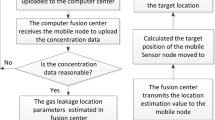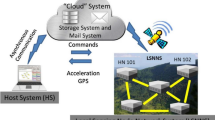Abstract
In order to prevent gas leakage, gas sensors are routinely deployed in chemical industrial parks to monitor it. However, because of the effects of weather conditions, such as wind speed and direction, these gas sensors may not be able to accurately monitor the concentration of the gas leak. Toxic and harmful gases not only do harm to the surrounding environment, but also to the health of nearby residents. In order to effectively monitor the occurrence of gas leakage, in this paper, a plan of setting up wireless sensor network on site is designed, which is based on the meteorological and gas characteristics. What’s more, the plan includes the rectangle plan, the fan plan and the annular plan. Also, it stipulates the optimization standard of sensor node position and deployment scheme and field experiments were carried out in the chemical industrial park, whereby the monitoring values of gas concentration in different schemes were obtained. According to the standards, the optimal deployment scheme and the optimal location of sensor nodes in different schemes are also procured. The results show that the method is feasible and effective. It can optimize the deployment position of different elevation under certain wind speed and wind direction as well as optimize different solutions.







Similar content being viewed by others
References
Bari A, Jaekel A, Bandyopadhyay S (2008) Clustering strategies for improving the lifetime of two-tiered sensor networks. Comput Commun 31(14):3451–3459
Becerra G, Kremer R (2011) Ambient intelligent environments and environmental decisions via agent-based systems. J Ambient Intell Humaniz Comput 2(3):185–200
Benavides-Serrano AJ, Legg SW, Vázquez-Román R, Mannan MS, Laird CD (2014) A stochastic programming approach for the optimal placement of gas detectors: unavailability and voting strategies. Ind Eng Chem Res 53(13):5355–5365
Borah SJ, Dhurandher SK, Woungang I, Kumar V, Barolli L (2018) A multi-objectives based technique for optimized routing in opportunistic networks. J Ambient Intell Humaniz Comput 9(3):655–666
Defriend S, Dejmek M, Porter L, Deshotels B, Natvig B (2008) A risk-based approach to flammable gas detector spacing. J Hazard Mater 159(1):142–151
Hanna SR, Steinberg KW (2001) Overview of petroleum environmental research forum (perf) dense gas dispersion modeling project. Atmos Environ 35(13):2223–2229
Jemili I, Ghrab D, Dhraief A, Belghith A, Derbel B, Al-Mogren A, Mathkour H (2015) CHRA: a coloring based hierarchical routing algorithm. J Ambient Intell Humaniz Comput 6(1):69–82
Jiang Y, He Z, Li Y, Xu Z, Wei J (2016) Weighted global artificial bee colony algorithm makes gas sensor deployment efficient. Sensors 16(6):888
Jiang Y, Xiao S, Liu J, Chen B, Zhang B, Zhao H, Jiang Z (2018) A deterministic sensor deployment method for target coverage. J Sens 2018:1–14
Kamapantula BK, Abdelzaher A, Ghosh P, Mayo M, Perkins EJ, Das SK (2014) Leveraging the robustness of genetic networks: a case study on bio-inspired wireless sensor network topologies. J Ambient Intell Humaniz Comput 5(3):323–339
Kuila P, Jana PK (2014) Approximation schemes for load balanced clustering in wireless sensor networks. J Supercomput 68(1):87–105
Kumar V, Kumar A (2019) Improved network lifetime and avoidance of uneven energy consumption using load factor. J Ambient Intell Humaniz Comput 10(4):1425–1432
Lee RW, Kulesz JJ (2008) A risk-based sensor placement methodology. J Hazard Mater 158(2–3):417–429
Legg SW, Benavides-Serrano AJ, Siirola JD, Watson JP, Davis SG, Bratteteig A, Laird CD (2012) A stochastic programming approach for gas detector placement using CFD-based dispersion simulations. Comput Chem Eng 47:194–201
Liu L, Masfary O, Antonopoulos N (2012) Energy performance assessment of virtualization technologies using small environmental monitoring sensors. Sensors 12(5):6610–6628
Matsuo K, Elmazi D, Liu Y, Sakamoto S, Barolli L (2015) A multi-modal simulation system for wireless sensor networks: a comparison study considering stationary and mobile sink and event. J Ambient Intell Humaniz Comput 6(4):519–529
Mergenci C, Korpeoglu I (2015) Routing in delay tolerant networks with periodic connections. Eurasip J Wirel Commun Netw 1:1–19
Musa A, Gonzalez V, Barragan D (2019) A new strategy to optimize the sensors placement in wireless sensor networks. J Ambient Intell Humaniz Comput 10(4):1389–1399
Reina DG, Toral SL, Barrero F, Bessis N, Asimakopoulou E (2013) Modelling and assessing ad hoc networks in disaster scenarios. J Ambient Intell Humaniz Comput 4(5):571–579
Seo JK, Du CK, Ha YC, Kim BJ, Palk JK (2013) A methodology for determining efficient gas detector locations on offshore installations. Ships Offshore Struct 8(5):524–535
Wang G, Guo L, Duan H, Liu L, Wang H (2012) Dynamic deployment of wireless sensor networks by biogeography based optimization algorithm. J Sens Actuator Netw 1(2):86–96
Yoon I, Dong KN, Shin H (2012) Multi-layer topology control for long-term wireless sensor networks. Eurasip J Wirel Commun Netw 1:1–9
Zhai Z, Srebric J, Chen Q (2003) Application of CFD to predict and control chemical and biological agent dispersion in buildings. Int J Vent 2(3):251–264
Acknowledgements
The authors acknowledge the support provided by the National Natural Science Foundation of China (JZ2019GJQN0385, 61701154) and the Fundamental Research Funds for the Central Universities of China (JZ2018HGTA0219, JZ2018HGBZ0178, JZ2019HGBZ0149, JZ2018HGBZ0177).
Author information
Authors and Affiliations
Contributions
The original idea was proposed by YJ. The further data sample and analysis were realized by QZ, SX, MQ, ZJ, JL, WY and LJ. YJ and MQ wrote the manuscript.
Corresponding author
Ethics declarations
Conflict of interest
The author declare no conflict of interest.
Additional information
Publisher's Note
Springer Nature remains neutral with regard to jurisdictional claims in published maps and institutional affiliations.
Rights and permissions
About this article
Cite this article
Jiang, Y., Zhou, Q., Xiao, S. et al. Optimized deployment method and performance evaluation of gas sensor network based on field experiment. J Ambient Intell Human Comput 12, 729–744 (2021). https://doi.org/10.1007/s12652-020-02055-2
Received:
Accepted:
Published:
Issue Date:
DOI: https://doi.org/10.1007/s12652-020-02055-2




